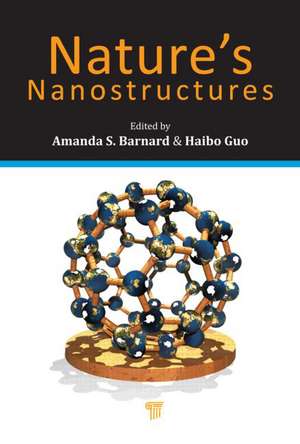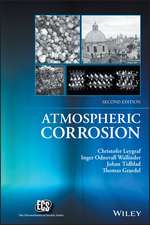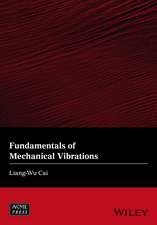Nature's Nanostructures
Editat de Amanda S. Barnard, Haibo Guoen Limba Engleză Hardback – 2 feb 2012
Preț: 908.72 lei
Preț vechi: 1108.20 lei
-18% Nou
Puncte Express: 1363
Preț estimativ în valută:
173.88€ • 181.55$ • 143.91£
173.88€ • 181.55$ • 143.91£
Carte tipărită la comandă
Livrare economică 05-19 aprilie
Preluare comenzi: 021 569.72.76
Specificații
ISBN-13: 9789814316828
ISBN-10: 9814316822
Pagini: 604
Ilustrații: 32 pg insert to go at end of book; 48 Illustrations, color; 109 Illustrations, black and white
Dimensiuni: 152 x 229 x 38 mm
Greutate: 0.95 kg
Ediția:1
Editura: Jenny Stanford Publishing
Colecția Jenny Stanford Publishing
ISBN-10: 9814316822
Pagini: 604
Ilustrații: 32 pg insert to go at end of book; 48 Illustrations, color; 109 Illustrations, black and white
Dimensiuni: 152 x 229 x 38 mm
Greutate: 0.95 kg
Ediția:1
Editura: Jenny Stanford Publishing
Colecția Jenny Stanford Publishing
Public țintă
Academic and PostgraduateCuprins
Preface. Naturally Occurring Inorganic Nanoparticles: General Assessment and a Global budget for One of Earth’s Last Unexplored Major Geochemical Components. Uncovering the Physical and Chemical Properties of Nanominerals and Mineral Nanoparticles. Nanostructures of Natural Iron Oxide Nanoparticles. Thermodynamic Modeling of FeS2.
Noble Metal Nanoparticles in Ore Systems. Diamondoids. Role of Nanopores in Regulating Reactivity and Transport of Uranium in Subsurface Sediments. Biomineralization of Natural Nanomaterials. Magnetic Nanoparticles in Magnetosomes. Nanoscale Magnetoreceptors in Birds. Nucleation and Growth of Biomaterials: the Role of Simulations for Understanding. Photonic Crystals in Beetles. Nanoparticles That Are Out of This World. Large Molecules and Nanograins in Space. Nanoparticles in the Solar System. Formation and Growth of Atmospheric Aerosol Particles. Engineered Nanoparticles and the Environment: Inadvertently and Intentionally Produced. Ultrafine Particles on and Near Roadways. Allophane and Imogolite Nanoparticles in Soil and Their Environmental Applications. Transformation of Engineered Nanostructures in the Natural Environment.
Noble Metal Nanoparticles in Ore Systems. Diamondoids. Role of Nanopores in Regulating Reactivity and Transport of Uranium in Subsurface Sediments. Biomineralization of Natural Nanomaterials. Magnetic Nanoparticles in Magnetosomes. Nanoscale Magnetoreceptors in Birds. Nucleation and Growth of Biomaterials: the Role of Simulations for Understanding. Photonic Crystals in Beetles. Nanoparticles That Are Out of This World. Large Molecules and Nanograins in Space. Nanoparticles in the Solar System. Formation and Growth of Atmospheric Aerosol Particles. Engineered Nanoparticles and the Environment: Inadvertently and Intentionally Produced. Ultrafine Particles on and Near Roadways. Allophane and Imogolite Nanoparticles in Soil and Their Environmental Applications. Transformation of Engineered Nanostructures in the Natural Environment.
Notă biografică
Haibo Guo is a postdoctoral fellow and an early-career researcher at Virtual Nanoscience Laboratory (VNLab), led by Dr. Amanda Barnard. He received his BS in 2001 and PhD in 2006 from Tsinghua University, Beijing, China. His research interests include modeling and simulation of surfaces and interfaces in environmental and energy sciences.
Amanda S. Barnard is leader of the Virtual Nanoscience Laboratory at the Commonwealth Scientific and Industrial Research Organisation (CSIRO), Australia’s national science agency. She has a BSc and PhD in physics from RMIT University, Australia, and has held research positions at Argonne National Laboratory (USA) and the University of Oxford (UK). Using thermodynamic theory and first principles computer simulations, she is a pioneer in the mapping of nanomorphology and the environmental stability of nanomaterials (thermodynamic cartography) and in the development of structure/property relationships for predicting the reliability of nanoparticles in high-performance applications.
Amanda S. Barnard is leader of the Virtual Nanoscience Laboratory at the Commonwealth Scientific and Industrial Research Organisation (CSIRO), Australia’s national science agency. She has a BSc and PhD in physics from RMIT University, Australia, and has held research positions at Argonne National Laboratory (USA) and the University of Oxford (UK). Using thermodynamic theory and first principles computer simulations, she is a pioneer in the mapping of nanomorphology and the environmental stability of nanomaterials (thermodynamic cartography) and in the development of structure/property relationships for predicting the reliability of nanoparticles in high-performance applications.
Recenzii
"At a time when we are concerned about the potential hazards of engineered nanomaterials, this book gives a timely and delightful overview of the variety of nanoparticles that exist in our environment — from noble metal nanoparticles in ore systems and nanodust in the solar system to magnetic nanoparticles in homing pigeons and photonic crystals in beetles. It is an enjoyable and a useful companion for anyone interested in knowing about the potential hazards of nanomaterials and those seeking inspiration from nature to create functional materials."
—Dr Ai Lin Chu - Senior Editor, Nature Nanotechnology
—Dr Ai Lin Chu - Senior Editor, Nature Nanotechnology
Descriere
Natural nanomaterials and nanotechnologies are all around us, which inevitably leads to these questions: What are these natural nanomaterials made of? Where can we find them? What can they do? Answering these questions will facilitate new and environmentally friendly ways of creating and manipulating nanoscale materials for the next generation of new technologies. A truly multidisciplinary resource, this book brings together studies from astronomy, physics, chemistry, materials science, engineering, geology and geophysics, environmental science, agricultural science, entomology, molecular biology, and health and provides an invaluable resource for learning how various scientists approach similar problems.





